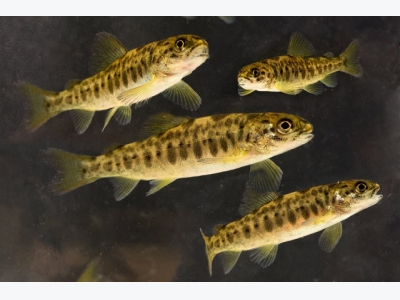Project to analyze water quality in juvenile salmon hatcheries

Humans have a bacterial flora in their gut that affects their state of health, and so do these little baby salmon. Fish also live in water that contains both “good” and “bad” bacteria. SINTEF is about to start studying this microbial environment in order to combat fish disease.Photo: SINTEF
Aim is to develop advance-warning system that will let a hatchery know when dangerous bacteria are blooming.
The water condition in salmon hatcheries can provide a great deal of information as to when and why outbreaks of disease occur. Now, SINTEF researchers are about to expose the water’s secrets, both to prevent suffering in fish and to save the aquaculture industry a great deal of money. SINTEF is a broad, multidisciplinary research organization based in Norway.
“Disease is the greatest challenge facing this industry both in financial terms and where its reputation with the public is concerned. Analyzing and improving our knowledge of the salmon’s environment will have significant economic potential. If this project enables us to produce knowledge and techniques that can be used to prevent disease, we will have taken several steps in the right direction,” said lead scientist Sven Martin Jørgensen at the Norwegian Seafood Research Fund (FHF).
For the next year-and-a-half, researchers at SINTEF Ocean will receive weekly water samples from three different land-based salmon hatcheries: Bremnes Seashore, Lerøy Midt and Laksefjord. The researchers will analyze the samples to map bacterial communities in the hatchery water and to find out what happens when there are outbreaks of bacteria that can lead to disease.
The research group’s aim is to develop an advance-warning system that will let a hatchery know when dangerous bacteria are in the process of blooming.
"This will enable hatcheries to take the necessary measures that, in good time, enable the fish to avoid problems,” SINTEF Ocean scientist Stine Wiborg Dahle said.
The research project, called MONMIC, is financed by FHF and the aquaculture industry. FHF already supports a number of projects aimed at improving water quality in enclosed facilities, precisely because such projects can improve fish health and prevent the aquaculture industry from suffering serious financial losses caused by outbreaks of disease and the loss of its reputation.
“The development of water recirculating systems has exploded in recent years, so we think it is time to develop tools that will enable us to understand and optimize the health of fish in hatcheries by monitoring the bacterial community in the water,” Jørgensen said.
Inger Lise Breivik, biology manager at Bremnes Seashore, explained, “For example, it is useful for us to know whether fish have been infected with disease before we move them into a recirculating aquaculture system (RAS) or transfer them between different sections of a hatchery. If the program can give us an early heads-up, we may be able to reduce the extent of damage to their health. It will also be exciting to follow up how the biofilter develops in order to find out which groups are dominant.”
Water monitoring can also provide hatcheries with important information regarding the water quality that produces more robust and healthy fish. Appropriate decision-making about operating routines and implementing preventive measures can improve survival rates when the fish are transferred to growing farms in the sea.
The project is unique in that this is the first time microbial water quality will be measured using modern analytical techniques, with frequent sampling over such a long time in hatcheries under normal production conditions.
“For example, in the future, a hatchery can be certain that it does not have dangerous bacteria in its water, because we will have been analyzing it over an extended period of time and have full control over it, unlike the current situation. Today, sampling is carried out when fish become sick, and by then, it is too late,” Dahle said.
The researchers envisage companies subscribing to a monitoring program, which would involve scientists analyzing and interpreting water quality in hatcheries on a regular basis.
“We believe that the aquaculture industry is gradually becoming more aware of microbial water quality. It will be exciting to be part of this project, which can help to set a new standard for the industry,” Dahle added.
SINTEF has international top-level expertise in the fields of technology, the natural sciences, medicine and the social sciences. It conducts contract research and development as a partner for the private and public sectors and is one of the largest contract research institutions in Europe.
Related news
Tools

Phối trộn thức ăn chăn nuôi

Pha dung dịch thủy canh

Định mức cho tôm ăn

Phối trộn phân bón NPK

Xác định tỷ lệ tôm sống

Chuyển đổi đơn vị phân bón

Xác định công suất sục khí

Chuyển đổi đơn vị tôm

Tính diện tích nhà kính

Tính thể tích ao




 New Study Shows Organic Farming Traps Carbon in…
New Study Shows Organic Farming Traps Carbon in…  Turning a profit on aquaculture waste
Turning a profit on aquaculture waste